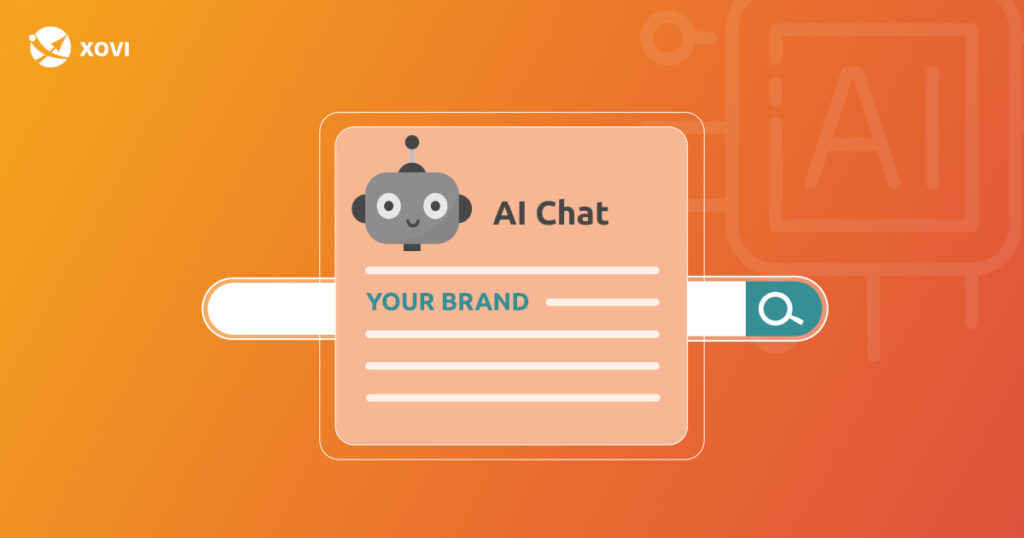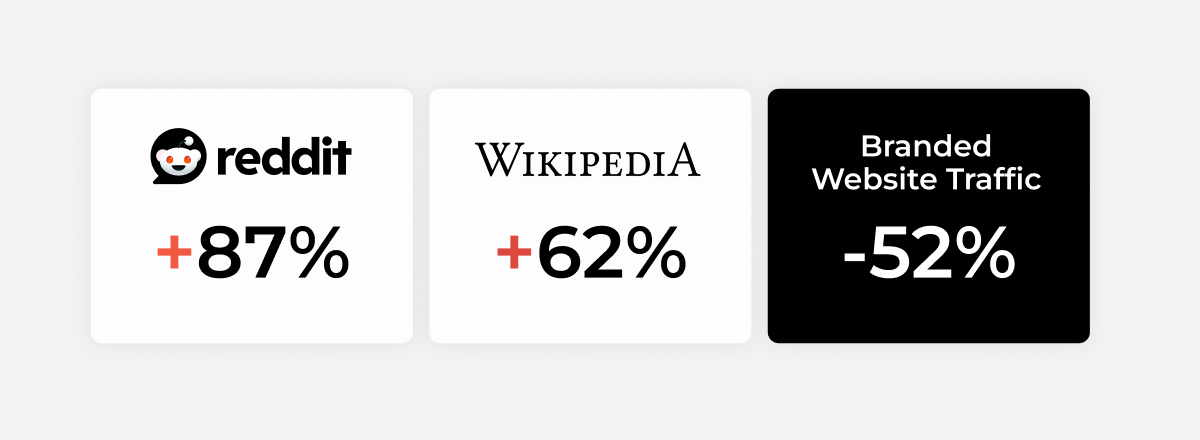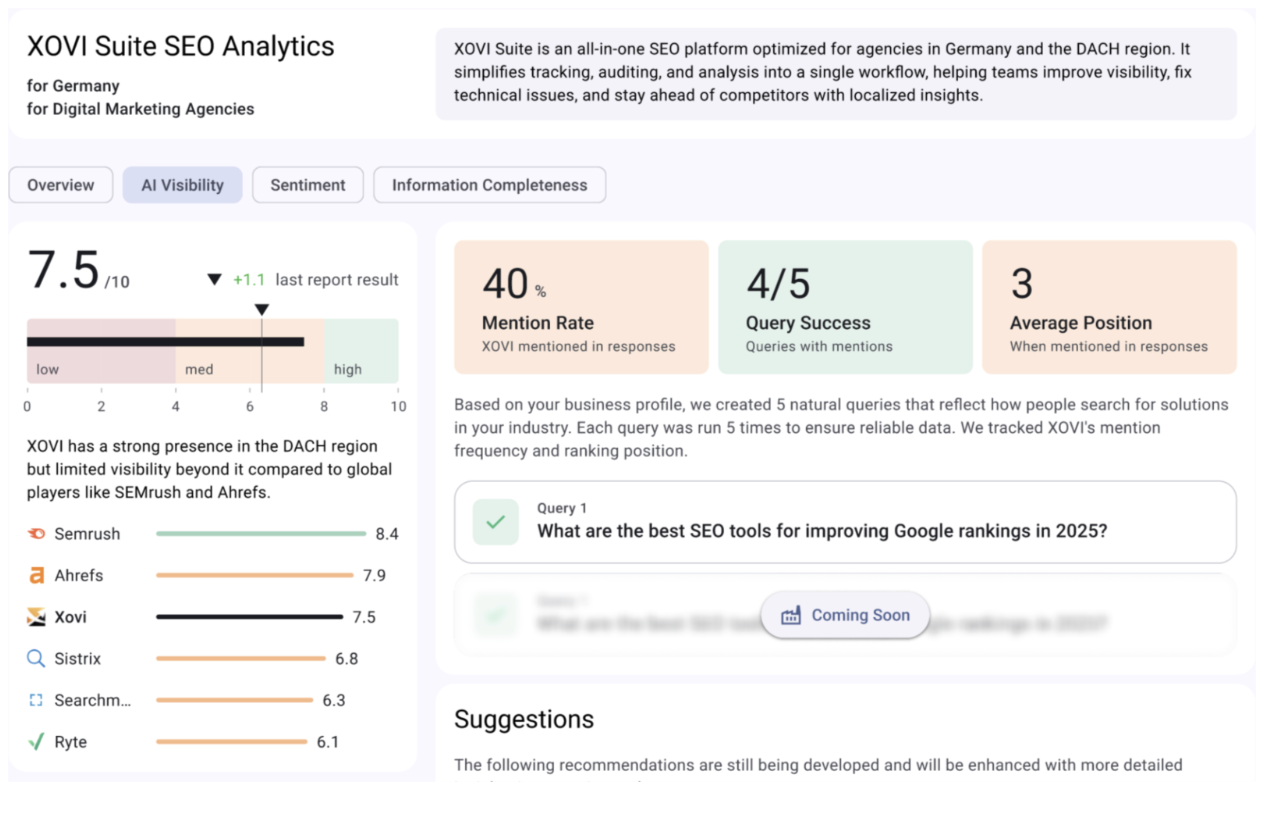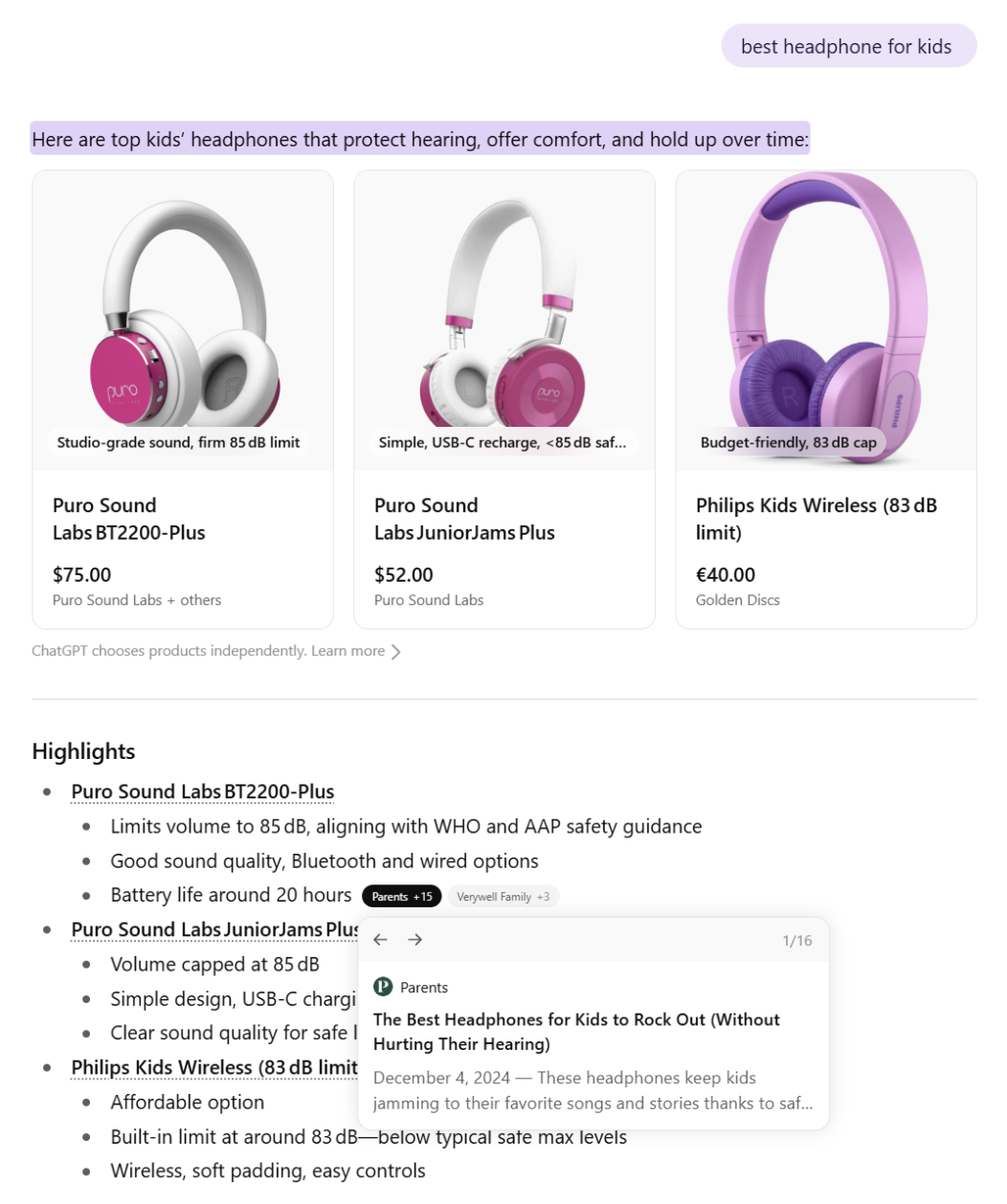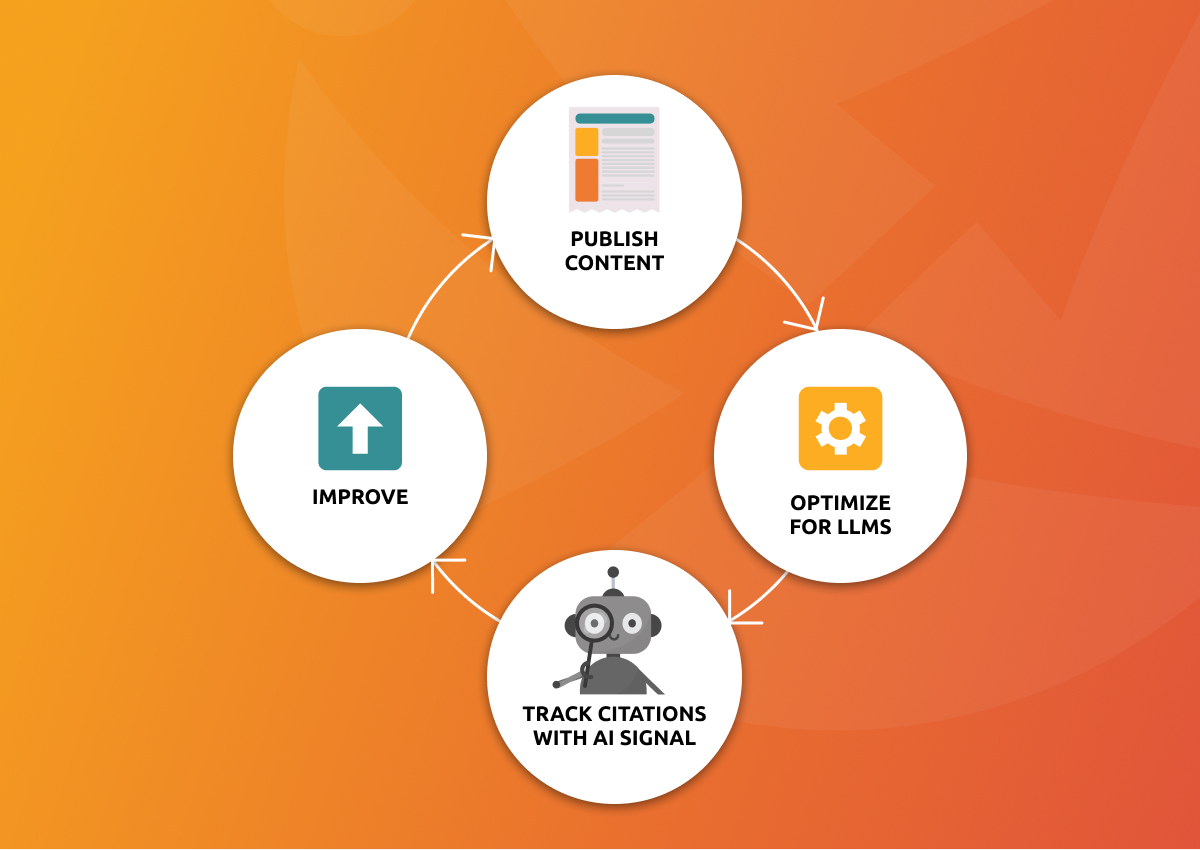(A practical guide for XOVI AI Signal users)
Introduction: The new battle for visibility
For two decades SEO was the game: rank on Google, win the click, earn the traffic.
But the game has changed. Today, brand visibility depends on how large language models (LLMs), AI-powered assistants, and Google’s AI Overviews present your business. Instead of 10 blue links, users now see a single AI-generated summary, often with just a few trusted citations.
And those citations are consolidating. According to Josh Blyskal, Head of AEO at Profound and SEO expert, referral traffic from ChatGPT to branded websites fell 52% after July 21, 2025. This was not due to a bug but to OpenAI favoring a narrow set of “answer-first” sources. Reddit citations rose +87%, Wikipedia +62%, and Reddit, Wikipedia, and TechRadar together now capture 22% of all mentions.
That is why we built XOVI AI Signal. It not only tracks how AI tools describe your brand but also delivers clear, research-backed recommendations on how to improve your visibility score.
TL;DR / Key Takeaways
- AI visibility is consolidating fast. Reddit mentions are up +87%, Wikipedia is up +62%, and together with TechRadar these three sources now account for 22% of all ChatGPT citations.
- Traffic from ChatGPT is shrinking. Referral clicks to branded websites dropped 52% after July 2025, according to Josh Blyskal, SEO expert and Head of AEO at Profound.
- Use XOVI AI Signal to track and improve your AI presence. The tool shows how ChatGPT, Gemini, and other AI systems describe your brand, and gives you actionable recommendations to boost your visibility score.
- Follow 11 credible rules for better results. These rules, validated by academic studies and official guidelines from Google, Microsoft, and Schema.org, cover content quality, technical health, authority signals, and structure.
- Take action within 30 days using XOVI. Competitive benchmarking and compliance checks reveal what competitors do better and give you a clear roadmap for quick improvements.
1. Publish Answer-First Content
AI tools reward clarity. Pages that answer directly in 40–60 words, with FAQ schema and comparison pages, are cited more often.
Best practices:
- Add a short, direct answer at the top of key pages.
- Use question-based H2s and H3s (“What is XOVI AI Signal?”).
- Implement FAQ and How-To schema markup.
- Publish alternatives or comparison pages (for example, XOVI vs Ahrefs).
💡 With XOVI Keyword Research you can spot the exact user questions LLMs are most likely to cite.
Start your 14-day free trial with XOVI
2. Strengthen Your Entity Footprint
LLMs cross-check your brand beyond your site. If you are missing from trusted sources, citations drop.
Where to appear:
- Wikipedia/Wikidata: accurate brand descriptions.
- Review sites: Trustpilot, OMR, G2, Capterra.
- Communities: Reddit, Quora, niche forums.
- PR with data: publish quotable stats and reports.
💡 Use XOVI Competitor Benchmarking to see where rivals are cited and where you are absent.
3. Fix Crawlability and Technical Barriers
Even great content fails if crawlers cannot see it. AI tools rely on indexed web data.
Key fixes to prioritize:
- Allow GPTBot and Google-Extended in robots.txt.
- Keep Core Web Vitals green (fast load speed, stable layout, quick interactivity).
- Use server-side rendering for SEO-critical pages.
- List all important URLs in your XML sitemap and verify them in Search Console.
- Structure pages with semantic HTML (clear headings, <article> and <section>, minimal empty <div>s).
💡 How XOVI helps: The XOVI Site Audit flags blocked crawlers, Core Web Vitals issues, missing schema, and hidden content, giving you a clear view of what AI tools can and cannot access.
4. Use Internal Linking to Build Authority
Internal linking strengthens both SEO and AI visibility by showing relationships between content.
Do this:
- Link from blogs to product and use-case pages.
- Use descriptive anchor text (AI Signal visibility reports instead of “click here”).
- Build topic clusters with pillar pages.
💡The XOVI SEO Dashboard flags underlinked pages so you can reinforce them.
5. Generate Brand Mentions Across the Web
Generative engines surface brands that are mentioned widely across the web. You can actively create these mentions, and they remain valuable even if they do not include a backlink. Both AI systems and search engines treat consistent brand mentions as signals of authority and relevance.
Tactics:
- Write guest posts for reputable sites.
- Respond to media and journalist requests. Tools like Qwoted connect you with journalists who are actively looking for expert quotes and sources.
- Contribute to Reddit, Quora, and niche forums.
- Get listed in trusted directories.
- Use affiliate and influencer marketing.
- Launch campaigns and events that spark coverage.
💡 With XOVI AI Signal, you can see which mentions already surface in ChatGPT and where you need more.
6. Publish In-Depth Content About Your Business
Shallow content does not get cited. AI tools look for detailed, credible coverage.
Types of Content to Create
- Tailored content for each audience (agencies, SMBs, e-commerce).
- In-depth product specifications.
- Direct comparisons between your solutions and competitors.
- Detailed use-case pages for services and industries.
- Guides on your unique selling points.
- Content about your brand values.
- Dedicated landing pages for each product, service, or location.
This content makes it easier for LLMs to associate your brand with highly specific prompts.
💡 Related: Use XOVI Content Analysis to check whether your pages are detailed enough for AI citation.
7. Embrace AEO and GEO Together
Traditional SEO is not enough.
- AEO (Answer Engine Optimization): format content for Google snippets and AI Overviews.
- GEO (Generative Engine Optimization): optimize so LLMs see you as a trusted, citable source.
Both require structured, factual, and clear content.
8. Track, Measure, and Improve With AI Signal
You cannot improve what you cannot measure.
With XOVI AI Signal, you can:
- See how ChatGPT, Claude, and Gemini describe your brand.
- Spot when competitors are cited instead of you.
- Detect outdated or missing brand information.
- Export AI visibility reports for your team or clients.
- Get actionable recommendations based on the 11 credible rules, achievable in 30 days
👉 This closes the loop: publish → optimize → track → improve.
FAQ: AI Mentions and Visibility
Q: What rules matter most for AI citations?
The 11 most credible rules, validated by academic research and official guidelines from Google, Microsoft, and Schema.org, cover:
- Content freshness indicators (last updated dates, versioning).
- Page load speed under one second.
- Schema markup (FAQ, Article, LocalBusiness).
- AI crawler permissions (robots.txt must allow GPTBot and Google-Extended).
- Core Web Vitals optimization (LCP, CLS, FID within thresholds).
- Server-side rendering for SEO-critical pages.
- FAQ sections in clear Q&A format.
- Statistical evidence integration (backed by credible sources).
- Credible citation practices (linking to authoritative references).
- E-E-A-T implementation (Expertise, Experience, Authoritativeness, Trustworthiness).
- Display of author credentials (bios, qualifications, certifications).
Q: How is XOVI different from other SEO tools?
Other tools stop at rankings. XOVI AI Signal combines AI mention tracking, competitor benchmarking, and compliance recommendations in one suite.
Q: What is the fastest fix for better citations?
Ensure crawlers such as GPTBot and Google-Extended can access your site and add answer-first sections with FAQ schema.
Q: What is GEO in simple terms?
Generative Engine Optimization means optimizing so AI tools cite your content in their answers.
Q: Is SEO still relevant?
Yes. Google snippets often feed AI answers. But SEO alone is not enough without GEO.
Q: How do I make my content accessible to AI crawlers?
Ensure clean HTML, indexable pages, valid schema, and no robots.txt or paywall blocks.
Q: How can I track if AI tools mention my brand?
With XOVI AI Signal, you can monitor how ChatGPT and others cite your brand, and where competitors appear instead.
Final thoughts
SEO is not dead. It is evolving. In 2025, being visible means optimizing for both search engines and generative engines.
With XOVI AI Signal, you do not just measure citations. You get evidence-backed recommendations that show what to fix, how to fix it, and how you compare to competitors.
If you are already using AI Signal, you are ahead of the curve and can test our beta features directly inside your account. If you are not yet a XOVI customer, start your 14-day free trial today – AI Signal will be available to you very soon.
